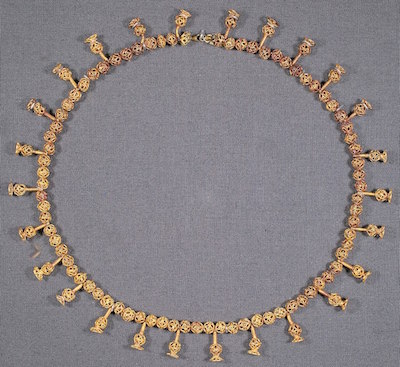KV 56 (also known as the “Gold Tomb”) is a tomb located in the Valley of the Kings. It is thought by some to be the intact burial of a royal child from the nineteenth dynasty (New Kingdom), but the identity of the deceased has not been confirmed and some have suggested that it was not a tomb but simply a cache of jewelry connected with KV 14 (the tomb of Tausret).

The tomb was first uncovered by Ayrton in 1908. While clearing it of its contents he discovered numerous stone and pottery vessels, some of which were inscribed with the throne name of Ramesses II, or the cartouches of Seti II and Tausret. He also found a remarkable cache of jewelry inscribed with the names of Seti II and Tausret. The tomb was visited again during the Amarna Royal Tombs Project in 2000, under the guidance of Nicholas Reeves. They added to the cache of nineteenth dynasty jewelry and also recovered a Hathor mask amulet.
Notable pieces from the cache include:
- A beautiful finger ring decorated with a falcon with its wings outstretched and the cartouche of Seti II,
- two cuff bracelets featuring a scene of Tausret (identified as the Great Wife of the King) pouring liquid into the cup of her husband Seti,
- a set of jewelry consisting of a diadem, earrings and a necklace with a rosette motif inscribed with the cartouche of Seti II and Tausret,
- a double finger ring featuring the cartouches of Tausret topped by two ostrich plumes,
- earrings with cartouches of Tausret topped with two falcon feathers,
- numerous other pieces formed from gold and glass or stone featuring the name of Tausret,
- a small silver sandal and a pair of gloves filled with gold rings inscribed with the names of Seti II, Tausret, and Ramesses II.

Reeves concluded that the tomb was originally built as the burial place for an Amarna era queen or princess. The tomb is similar to KV 63, which dates to this period, but the burial chamber is oddly shaped and does not fit the plan of other contemporary tombs.
It is possible it was never completed, and there is no evidence that it was actually used as a tomb during the eighteenth dynasty. The fact that it was filled with items dated to the nineteenth dynasty has led to much speculation. Maspero suggested that the haul was a cache of jewelry which had been retrieved from KV 14 when it was usurped by Ramesses III for the burial of his father, Setnakht. It is not clear why the gold, which would have been worth a great deal, would have been reburied by people who were happy to usurp the tomb from which it was taken. Aldred remained convinced it was the intact, but badly damaged, burial of an unnamed child of Seti II and Tausret.
The remains of gilded stucco inlaid with faience curls typical of the decoration of a coffin were found near to the jewelry along with the silver sandals and gloves, which would seem to support Aldred’s view that there was a burial in the tomb. However, Reeves team found no evidence of the mud sealings which would have secured the door following a burial, and Ayrton confirmed that the shaft was filled with debris washed in by flood water, suggesting the tomb was still open when the nineteenth dynasty objects were introduced. Furthermore, not a single scrap of bone was found at the site.
Roehrig has noted that the objects seem to come from more than one burial, even if a number of them make reference to Seti II and Tausret. She notes that the cache could have been left by tomb robbers, although the find of a pottery jar filled with fragments inscribed with the names of kings is more indicative of an attempted clean-up by officials. We may never know for sure.
Bibliography
- Dodson, Aiden (2016) The Royal Tombs of Ancient Egypt
- Reves, N and Wilkinson, R.H. (1996) The Complete Valley of the Kings
- Wilkinson, Richard H. Editor (2012) Tausret: Forgotten Queen and Pharaoh of Egypt
- Ziegler, Christine Editor (2008) Queens of Egypt: From Hetepheres to Cleopatra
Copyright J Hill 2018